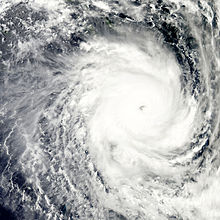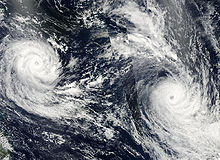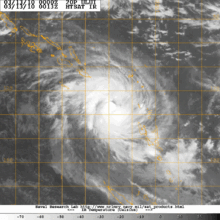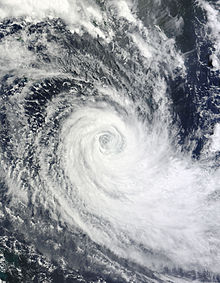- Cyclone Ului
-
Severe Tropical Cyclone Ului Category 5 cyclone (Australian scale) Category 5 Tropical Cyclone (SSHS) 
Ului near peak intensity on March 14, 2010 Formed 9 March 2010 Dissipated 21 March 2010 Highest winds 10-minute sustained:
215 km/h (130 mph)
1-minute sustained:
260 km/h (160 mph)Lowest pressure 915 mbar (hPa; 27.02 inHg) Fatalities 1 direct Damage $72 million (2010 USD) Areas affected Vanuatu, Solomon Islands and coastal Queensland Part of the 2009–10 South Pacific and Australian region cyclone seasons Severe Tropical Cyclone Ului was one of the fastest intensifying tropical cyclones on record, strengthening from a tropical storm to a Category 5 equivalent cyclone within a 30 hour span. Throughout Queensland, Australia, infrastructural damage from the storm amounted to A$20 million ($18 million USD) and agricultural losses reached A$60 million ($54 million USD)
Contents
Meteorological history
Severe Tropical Cyclone Ului was first identified by the Fiji Meteorological Service (FMS) late on 9 March 2010 roughly 130 kilometres (81 mi) north of Hiw Island, Vanuatu. At that time, the system was classified as Tropical Disturbance 13F.[1] Early the following day, the system became sufficiently organised for the FMS to upgrade the disturbance to a tropical depression.[2] Several hours later, the Joint Typhoon Warning Center (JTWC) also began monitoring the system. By this time, deep convection had developed around a low-level circulation and banding features had formed. A slow westward movement was expected as the depression was situated north of a subtropical ridge.[3]
On 12 March, 13F was upgraded to Tropical Cyclone Ului. By early on 13 March, it was a category 2 cyclone. Later that day, Ului strengthened into a category 3, making it a severe tropical cyclone. The storm continued to strengthen throughout the day and that night it became a category 5. Ului became the first category 5 South Pacific cyclone since Severe Tropical Cyclone Percy in February 2005 but weakened to category 4 about the time it crossed the 160°E meridian. Ului was predicted to restrengthen back into a category 5 as it moved away from an upper level low and Severe Tropical Cyclone Tomas, however Ului remained as a category 4 and had weakened to a category 3 system in the early hours of 18 March.[4] It weakened further to category 2 for a while before regaining category 3 strength. Early on 21 March (local time) it crossed the outlying Whitsunday Islands and made landfall near Airlie Beach, Queensland.[5]
Preparations
Solomon Islands
As the storm approached the Solomon Islands, officials advised that most vessels remain at port due to rough seas produced by Ului. Search and rescue personnel were also placed on standby.[6] On 16 March, UNICEF announced that they would supply the Solomon Islands with relief funds following the passage of the cyclone.[7] During the passage of the storm, airport officials cancelled many flights due to dangerous weather conditions. These cancellations took place over a two day span, leaving many passengers stranded during the storm.[8]
New Caledonia
Even though Ului passed through Météo-France's New Caledonia zone of responsibility, forecasters decided that there was no need to instate a pre-alert status as all forecasts showed that Ului wouldn't affect New Caledonia.[9]
Australia
After Cyclone Ului passed through the Solomon Islands, officials in Queensland, Australia began warning residents about the possibility of the storm making landfall in the region. Large swells produced by the system prompted lifeguards to close large areas of public beaches. People who wanted to go into the ocean were strongly urged to only do so in patrolled areas. Additionally, fishermen removed their shark nets from the region in anticipation of winds exceeding 65 km/h (40 mph).[10] The removal of shark nets was a first in preparation for cyclones. Although the removal of the nets would prevent damage to them from the storm, it left swimmers at risk for shark attacks.[11] A large surfing competition, the Australian Surf Life Saving Championships, welcomed the large swells from the storm, estimated at 5 m (16 ft). Roughly 8,100 people signed up for the competition; however, managers stated that if the swells continued to increase, they may have to relocate the event elsewhere.[12] These swells were anticipated to be the largest experienced along the Queensland coastline in the past decade and emergency management officials warned residents living along coastal areas that the waves would likely inundate low-lying regions.[13]
On 18 March, new forecasts of the future track of Ului indicated that it would make landfall in Queensland. As a result, officials evacuated roughly 300 people from the islands of Heron and Lady Elliot, situated about 1,000 km (620 mi) off the Australian mainland. Residents along the Sunshine Coast were advised to prepare their homes for a possible Category 4 cyclone and stock up on non-perishable foods.[14] Later on 18 March, the Bureau of Meteorology expected that the cyclone would cross or near the Queensland coast, between Cardwell and Mackay, on 21 March as a category 3 cyclone.[15] on 19 March, Ului was downgraded to a category 2 cyclone.[16] Several ports along the Queensland coastline were shut down for several days as large waves impacted the region. Transportation of coal and other raw materials was halted in these areas as well.[17] On 21 March the cyclone weakened as it moved inland[18] and was downgraded below cyclone strength.[19] 60,000 homes were without power in Cannonvale, Mackay, Proserpine, Sarina and surrounding areas. Most of the major damage occurred at Proserpine and the areas to the south and west such as Crystalbrook, Kelsey Creek, Silver Creek, Dittmer, Gunyarra, Andromache, Bloomsbury, Thoopara etc. Airlie Beach/Cannonvale/Cannonvalley sustainted relatively minor damage due to them being sheltered from most of the damaging winds by the conway ranges which the Conway National Park is part of Airlie Beach/Cannonvale/Cannonvalley sustainted relatively minor damage due to them being sheltered from most of the damaging winds by the conway ranges which the Conway National Park is part of.[18] A National Rugby League match in the region threatened by Ului was started roughly two hours early to avoid playing during the storm.[20]
Impact
Solomon Islands
As a Category 5 cyclone, Ului passed through the southern Solomon Islands, causing severe damage on the islands of Rennell, Guadalcanal as well as Bellona province. Large swells produced by the storm washed away several homes along coastal areas.[21] Flooding was also reported on several islands; however, officials confirmed that no fatalities resulted from the storm.[6] Maximum winds on the affected islands reached 120 km/h (75 mph). On Rennell Island, initial reports stated that at least ten homes had been severely damaged or destroyed in several villages. Light to moderate damage was sustained on Makira and Guadalcanal, with at least two homes sustaining damage. Unconfirmed reports of a large wave inundating several villages, washing away homes and overturning large boulders came from east Makira around 4:00 pm local time. Another village on the western side of Makira was reportedly inundated roughly five hours later.[22] Later damage assessments made on Makira Island confirmed at least 13 homes were destroyed and several more were damaged. The most severe damage took place in Woau village where ten homes were destroyed.[23]
Australia
On 19 March, a teenage surf lifesaver, Saxon Bird, was knocked off his surf ski amidst 2 m (6.6 ft) waves produced by Ului. After being struck by his ski, he was transported to a local hospital before dying from his injuries hours later. As a result of his death, the water events of the Australian Surf Life Saving championships at Kurrawa Beach on the Gold Coast were cancelled.[24] The system made landfall near Airlie Beach, north of Mackay, at about 1:30am AEST on Sunday Morning 21 March and headed in a SSW direction mainting catergory 3 status until it reached roughly half way between Proserpine, Queensland and Collinsville, Queensland.
Authorities say there are reports of roof damage and powerlines down communities throughout the region. 60,000 homes were reported to be without power between Mackay, Proserpine and Collinsville. Some sites reported over 400mm of rain in 24 hours.[25][26][27]
Aftermath and records
Between 13 and 14 March, Cyclone Ului underwent an unusually explosive phase of rapid intensification. During a 24 hour span, the system intensified from a tropical storm to a Category 5 equivalent cyclone, tying Hurricane Wilma in 2005 for the fastest intensification of a system from tropical storm to Category 5. According to the JTWC, maximum sustained winds increased from 100 km/h (65 mph) to 260 km/h (160 mph). They also estimated that the storm's minimal central pressure had decreased from 982 mbar (hPa) to 918 mbar (hPa), a drop of 64 mbar (hPa), during this span.
See also
- List of the most intense tropical cyclones
- Lists of tropical cyclones
- 2009–10 South Pacific cyclone season
- 2009–10 Australian region cyclone season
References
- ^ "Marine Weather Bulletin". Fiji Meteorological Service. 9 March 2010. http://www.webcitation.org/5o6qCvKIe. Retrieved 18 March 2010.
- ^ "Tropical Disturbance Summary". Fiji Meteorological Service. 10 March 2010. http://www.webcitation.org/5o7n1uRhA. Retrieved 18 March 2010.
- ^ "Significant Tropical Weather Outlook". Joint Typhoon Warning Center. 10 March 2010. ftp://ftp.met.fsu.edu/pub/weather/tropical/GuamStuff/2010031016-ABPW.PGTW. Retrieved 18 March 2010.
- ^ Trenwith, Courtney (18 March 2010). "Ului eases but still bound for coast". The Brisbane Times. http://www.brisbanetimes.com.au/queensland/ului-eases-but-still-bound-for-coast-20100318-qg5v.html. Retrieved 18 March 2010.
- ^ "Tropical Cyclone Advice Number 21". Bureau of Meteorology, Brisbane. 20 March 2010. http://www.webcitation.org/5oNEiFqiN. Retrieved 20 March 2010.
- ^ a b Moffat Mamu (16 March 2010). "Cyclone keeps ships in port". Solomon Star Newspaper. http://www.solomonstarnews.com/news/national/3885-cyclone-keeps-ships-in-port. Retrieved 16 March 2010.
- ^ Staff Writer (16 March 2010). "UNICEF on standby to help hurricane hit Fiji and Solomon Islands". UNICEF. http://www.unicef.org.uk/press/news_detail.asp?news_id=1486. Retrieved 16 March 2010.
- ^ Moffat Mamu (17 March 2010). "Cyclone disrupts domestic flights". Solomon Star News. http://www.solomonstarnews.com/news/business/3953-cyclone-disrupts-domestic-flights-. Retrieved 17 March 2010.
- ^ http://www.wmo.int/pages/prog/www/tcp/Meetings/RA%20V%20TCC-13/documents/Doc_4.2_1_NewCaledonia.doc
- ^ Jo Skinner and Kristy Sexton-McGrath (16 March 2010). "Wild weather sparks beach safety warning". ABC News. http://www.abc.net.au/news/stories/2010/03/16/2846880.htm. Retrieved 16 March 2010.
- ^ Courtney Trenwith (16 March 2010). "Swimmers exposed as shark nets removed". Brisbane Times. http://www.brisbanetimes.com.au/queensland/swimmers-exposed-as-shark-nets-removed-20100315-q7ot.html. Retrieved 16 March 2010.
- ^ Tony Bartlett (16 March 2010). "Entrants hoping for huge surf at Kurrawa". The Sydney Morning Herald. http://news.smh.com.au/breaking-news-sport/entrants-hoping-for-huge-surf-at-kurrawa-20100316-qbse.html. Retrieved 16 March 2010.
- ^ Courtney Trenwith (16 March 2010). "Cyclone Ului to head south along coast". Brisbane Times. http://www.brisbanetimes.com.au/queensland/cyclone-ului-to-head-south-along-coast-20100316-qa4e.html. Retrieved 16 March 2010.
- ^ Rosanne Barrett (18 March 2010). "Queensland towns batten down as Cyclone Ului looms". The Australian. http://www.theaustralian.com.au/news/nation/queensland-towns-batten-down-as-cyclone-ului-looms/story-e6frg6nf-1225842062004. Retrieved 17 March 2010.
- ^ "Towns brace as cyclone watch continues". Australian Broadcasting Corporation. ABC News. 18 March 2010. http://www.abc.net.au/news/stories/2010/03/18/2849589.htm?section=justin. Retrieved 18 March 2010.
- ^ "Downgraded cyclone edges closer to Qld coast". Australian Broadcasting Corporation. ABC News. 19 March 2010. http://www.abc.net.au/news/stories/2010/03/19/2850594.htm?section=justin. Retrieved 20 March 2010.
- ^ Ben Sharples (18 March 2010). "Coal Port Shut as Cyclone Nears Queensland Coast (Update2)". Business Week. http://www.businessweek.com/news/2010-03-18/coal-port-shut-as-cyclone-nears-queensland-coast-update2-.html. Retrieved 18 March 2010.
- ^ a b "Tropical Cyclone Ului moving inland, weakening". Australia Times. 21 March 2010. http://www.australia-times.com.au/national/article.php?id=1774. Retrieved 21 March 2010.
- ^ "Ului downgraded below cyclone strength". Australia Times. 21 March 2010. http://www.australia-times.com.au/national/article.php?id=1779. Retrieved 21 March 2010.
- ^ Australian Associated Press (19 March 2010). "Cyclone forces early start to NRL clash". The Sydney Morning Herald. http://news.smh.com.au/breaking-news-sport/cyclone-forces-early-start-to-nrl-clash-20100319-qlh4.html. Retrieved 19 March 2010.
- ^ Staff Writer (16 March 2010). "Guadalcanal And Other Three Areas’s Experience From Cyclone Ului". The Two Minute News. http://www.twominutenews.com/2010/world/us-world/guadalcanal-and-other-three-areass-experience-from-cyclone-ului-5828.html. Retrieved 16 March 2010.
- ^ Ednal Palmer (Solomon Times) (17 March 2010). "Cyclone Ului Leaves Moderate Damage in Solomons". Pacific Islands Report. http://pidp.eastwestcenter.org/pireport/2010/March/03-17-12.htm. Retrieved 17 March 2010.[dead link]
- ^ NDMO (17 March 2010). "Damages reported after cyclone Ului". Solomon Star News. http://www.solomonstarnews.com/news/national/3941-damages-reported-after-cyclone-ului. Retrieved 17 March 2010.
- ^ Associated Press (19 March 2010). "Competitior dies at surf lifesaving event". USA Today. http://www.usatoday.com/sports/olympics/2010-03-19-3504289249_x.htm. Retrieved 19 March 2010.
- ^ Sophie Elsworth, Neale Maynard, Robyn Ironside and AAP (20 March 2010). "Cyclone Ului re-intensifies to category 3, crosses coast at 1.30am Sunday". Courier Mail, Brisbane. http://www.couriermail.com.au/news/features/cyclone-ului-set-to-hit-proserpine-at-6am-sunday-with-10m-seas-and-destructive-winds/story-e6freorf-1225842633768. Retrieved 20 March 2010.
- ^ Josh Bavas, Marlina Whop, Niki Lyons, Melissa Maddison, Maree Hawthorne and Chris Logan (20 March 2010). "North Queensland assesses cyclone damage". ABC News. http://www.abc.net.au/news/stories/2010/03/21/2851661.htm. Retrieved 20 March 2010.
- ^ Josh Bavas, Melissa Maddison, Sigrid Brown, Penny Timms, Marlina Whop, Chris O'Brien, Gail Burke, Katherine Spackman and Alex Strange (21 March 2010). "Cyclone-ravaged north Queensland 'dodges a bullet'". ABC News. http://www.abc.net.au/news/stories/2010/03/21/2851870.htm. Retrieved 21 March 2010.
External links
- Fiji Meteorological Service (RSMC Nadi)
- Australian Bureau of Meteorology (TCWC's Perth, Darwin & Brisbane).
- Joint Typhoon Warning Center (JTWC)
Tropical cyclones of the 2009–10 South Pacific cyclone season
USouth Pacific Tropical Cyclone Scale TDI TDE 1 2 3 4 5  Book ·
Book ·  Category ·
Category ·  Portal ·
Portal ·  WikiProject ·
WikiProject ·  Commons
CommonsTropical cyclones of the 2009–10 Australian region cyclone season
L020304NMO0810PRSAustralian Tropical Cyclone Scale TL 1 2 3 4 5  Book ·
Book ·  Category ·
Category ·  Portal ·
Portal ·  WikiProject ·
WikiProject ·  Commons
Commons1970s 1980s 1990s 2000s 2010s Categories:- Retired South Pacific cyclones
- 2009–10 South Pacific cyclone season
- Tropical cyclones in the Solomon Islands
- Tropical cyclones in Vanuatu
- Cyclones in Australia
- Category 5 South Pacific cyclones
- Category 4 Australian region cyclones
Wikimedia Foundation. 2010.




